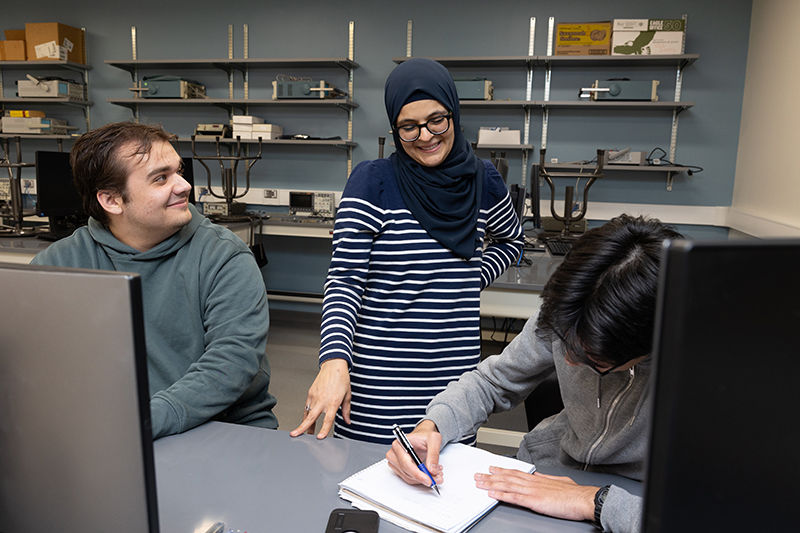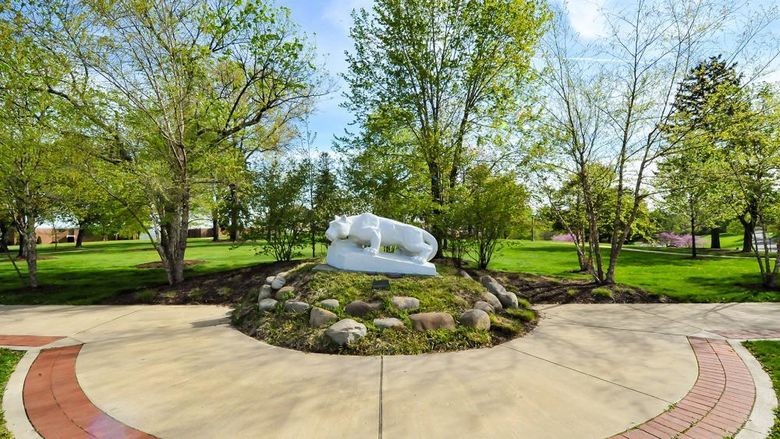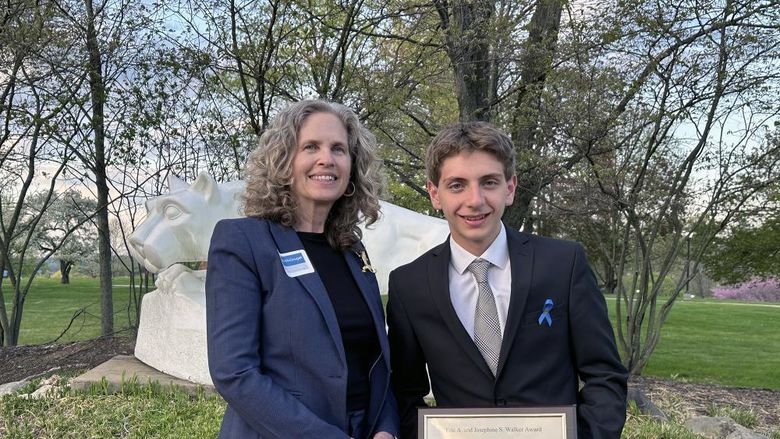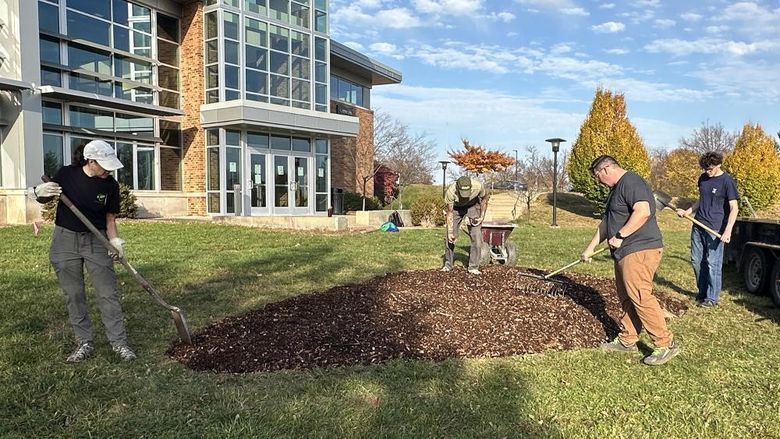
Nathaniel Luffey, a third-year computer science major, smiles as Dr. Haifa Abulaiha, assistant teaching professor of engineering, looks over work being completed by Basam Ahmed, a second-year electrical engineering student.
MONACA, Pa. — Haifa Abulaiha had two options when she graduated from high school in Libya: Go to medical school or go into engineering.
Since she didn’t particularly like biology and chemistry in high school, and she loved math and physics, engineering was the obvious choice.
Madhurima Ray grew up with a father who was an electrical and electronic engineer who inspired her to go into engineering. But it was a 386 processor with a one megabyte hard disk and DOS operating system she came across in middle school that spurred her love for computers. Support from her teachers helped to drive her decision to become a computer engineer.
For Muhammad Khan a childhood fascination with airplanes, and especially the Boeing 747, inspired his choice to go into engineering. He loved everything from the loud engine sound, the stairs to the plane, tickets in the form of a whole booklet, take-off, landing, food and pilots. Everything was magical to him. He also excelled in mathematics and physics, so engineering was a natural fit.
Now Abulaiha, Ray and Khan are bringing their unique backgrounds to Penn State Beaver to not only provide high-quality education to future engineers but also to make their classrooms more inclusive, where students can find community and a sense of belonging.
“Penn State Beaver’s diverse engineering faculty are committed to student success through engaging students in real world applications, bringing industry partners into the classroom and helping students pave a rich pathway into their careers,” said Interim Chancellor Carey McDougall.
Ray, an assistant professor, said the campus’s engineering program is “all about diversity. If you look through the faculty list, each of us are from different ethnic backgrounds, yet it makes the perfect department. In fact, most of us, including me, are immigrants.”
Strength through diversity
According to the Society of Women Engineers, only 18% of software developers and 32% of computer and information research scientists are women. And according to Data USA, in 2021 the computer engineering and science workforce was only 17.1% Asian and 6.9% Black. The U.S. National Science Foundation found only 15% of the total STEM workforce in 2021 identified as Hispanic.
The professors at Penn State Beaver said they recognize the importance of increasing diversity in their field.
“Engineers strive to improve the quality of life through innovations and creative solutions," said Kahn, an assistant teaching professor. "Diversity and inclusion bring strength in terms of being able to think more broadly. It allows for the cultivation of scientific talent. Two people from different social backgrounds can bring differences in perspective and life experiences that can result in breakthroughs in the fields.”
Ray said she has the privilege to work with people from different countries, races, religions, genders and socio-economic backgrounds.
“My experience after working with a diverse workforce is every day you would learn something new that would enlighten you,” she said. “I believe the field of engineering is enriched with the inclusion of these powerful approaches that come from people of diverse backgrounds. Just think about engineering without women, it is impossible for any discipline to make progress without considering the contribution from a significant portion of the population.”
Abulaiha, an assistant teaching professor, said people are becoming more aware of the importance of diversity, however there are still strides to be made.
“In Penn State Beaver’s engineering program, as everywhere else, female students are very underrepresented," Abhlaiha said. "I taught few classes where they were all males. ... However, I could proudly say that females are very well represented when it comes to faculty in Penn State Beaver. I think this sets a very good example and role models for female students to pursue engineering and science majors.”
Inclusivity in the classroom
Each engineering professor at Penn State Beaver said they strive for an inclusive classroom that is supportive of all students.
Khan said he uses an approach he calls “four simple As: acknowledge, acquaint, accommodate and applaud.”
He acknowledged the presence of historical biases that lead to inequitable and unfair treatment of some people.
My in-class inclusive practices are not about lifting a group of students to some normative standard. I recognize that all students are equally able to learn, but they do not share the same starting point. Therefore, instead of lowering my grading standards, I commit to removing any obstacles so that all students can perform to the best of their abilities and achieve their full potential.—Muhammad Khan , assistant teaching professor of engineering
“My in-class inclusive practices are not about lifting a group of students to some normative standard. I recognize that all students are equally able to learn, but they do not share the same starting point,” he said. “Therefore, instead of lowering my grading standards, I commit to removing any obstacles so that all students can perform to the best of their abilities and achieve their full potential.”
He said he acquaints underrepresented groups with their abilities to increase their contribution.
“I believe that the lack of opportunity and awareness is the underlying key to the underrepresentation of some groups in STEM. … I have participated in various outreach activities focused on increasing the enrollment of women and African American students in STEM fields," he said.
He accommodates students to provide them with an equal opportunity to achieve excellence.
“I seek to design my lessons so that they incorporate analogies and references from diverse cultures and backgrounds,” he said. “I ask students for accommodations, [due to] religious or disability [needs] before scheduling exams. I document and post all of my lectures, aiding students who have difficulty in note-taking. I do not leave my unconscious prejudices unchecked and ask students to introduce themselves using any pronouns they prefer.”
Finally, he said he applauds the accomplishments of these diverse groups of students in class and online.
“I seek to highlight their success by publishing stories in [social media] feeds, departmental newsletters, university tabloids, etcetera," he said.
Teaching to impact lives
Kahn said teaching is a chance to change the lives of learners.
“I want students to be more skilled [and] knowledgeable and [to become] experts in their field to solve the challenges of the 21st century,” he said. “Higher education provides me with an opportunity to be more reflective about my engineering practices. My goal is to create an ideal learning environment where future engineers have a quest for design, the ability to conceptualize and develop industrial connections through exposure, learn problem-solving through concrete examples, and engage in hands-on working experience.”
Abulaiha said diversity impacts all fields, not just engineering, and she recognizes the role teachers have in increasing diversity.
“As engineering educators, we could make this change by encouraging more minorities to pursue engineering and enlighten people about the importance of diversity in engineering,” she said.
The impact she could have on students, especially underrepresented students including women and people of color, by being a role model inspired Abulaiha to teach.
“I always tell my students, ‘If I can do it, you sure can do it. You might have different experiences and might face different challenges, but you will get there.’ And the more I work in higher education the more passionate I become,” she said.
Ray said she realized teaching was her dream job after working as a part-time private tutor and then as an adjunct professor while she earned her master’s degree at the University of Calcutta in India.
“However, as a doctoral student, I never got the opportunity to teach anyone because, all the time, I was working [in my lab],” she said. “I was waiting for the right time and opportunity to come back to this field. I got this opportunity [at Penn State Beaver] in March 2022, I thought it would be the best career option to pursue my dream job of teaching … I love to teach, and it feels really rewarding to see your students succeed.”





